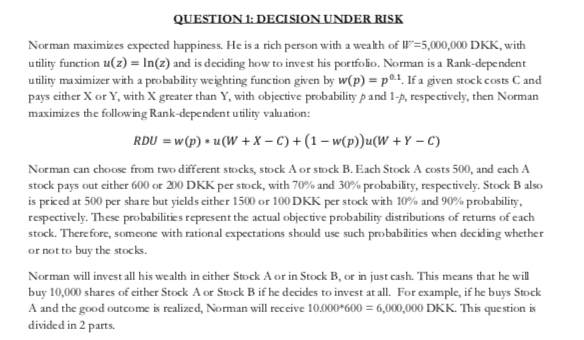

a QUESTION 1: DECISION UNDER RISK Norman maximizes expected happiness. He is a rich person with a wealth of W=5,000,000 DKK, with utility function u(z) = ln(2) and is deciding how to invest his portfolio. Norman is a Rank-dependent utility maximizer with a probability weighting function given by w(p) = p.1. If a given stock costs and pays either X or Y, with X greater than Y, with objective probability pand 1-p, respectively, then Norman maximizes the following Rank-dependent utility valuation: RDU =w(p) u(W + x 2) + (1 (P2)(W +Y C) Norman can choose from two different stocks, stock A or stock B. Each Stock A costs 500, and cach A stock pays out either 600 or 200 DKK per stock, with 70% and 30% probability, respectively. Stock B also is priced at 500 per share but yields either 1500 or 100 DKK per stock with 10% and 90% probability, respectively. These probabilities represent the actual objective probability distributions of returns of each stock. Therefore, someone with rational expectations should use such probabilities when deciding whether or not to buy the stocks. Norman will invest all his wealth in either Stock A or in Stock B, or in just cash. This means that he will buy 10,000 shares of either Stock A or Stock B if he decides to invest at all. For example, if he buys Stock A and the good outcome is realized, Norman will receive 10.000*600 = 6,000,000 DKK. This question is divided in 2 parts. QUESTION 1 - PART 2: Now, suppose that Norman has been checking the financial news lately, and he has become convinced that al signs indicate that there could be an economic/financial recession coming and he becomes "financially" scared. When Norman feels this scare, his reaction is to become pessimistic towards probabilities, and his probability weighting function changes to w(p) = p 25 Re-evaluate Norman's choices in part 1 of this question. Does he invest in Stock A? In Stock B? Or not invest at all? If there is a change in investment preferences, how can you intuitively explain the nature of this change? a QUESTION 1: DECISION UNDER RISK Norman maximizes expected happiness. He is a rich person with a wealth of W=5,000,000 DKK, with utility function u(z) = ln(2) and is deciding how to invest his portfolio. Norman is a Rank-dependent utility maximizer with a probability weighting function given by w(p) = p.1. If a given stock costs and pays either X or Y, with X greater than Y, with objective probability pand 1-p, respectively, then Norman maximizes the following Rank-dependent utility valuation: RDU =w(p) u(W + x 2) + (1 (P2)(W +Y C) Norman can choose from two different stocks, stock A or stock B. Each Stock A costs 500, and cach A stock pays out either 600 or 200 DKK per stock, with 70% and 30% probability, respectively. Stock B also is priced at 500 per share but yields either 1500 or 100 DKK per stock with 10% and 90% probability, respectively. These probabilities represent the actual objective probability distributions of returns of each stock. Therefore, someone with rational expectations should use such probabilities when deciding whether or not to buy the stocks. Norman will invest all his wealth in either Stock A or in Stock B, or in just cash. This means that he will buy 10,000 shares of either Stock A or Stock B if he decides to invest at all. For example, if he buys Stock A and the good outcome is realized, Norman will receive 10.000*600 = 6,000,000 DKK. This question is divided in 2 parts. QUESTION 1 - PART 2: Now, suppose that Norman has been checking the financial news lately, and he has become convinced that al signs indicate that there could be an economic/financial recession coming and he becomes "financially" scared. When Norman feels this scare, his reaction is to become pessimistic towards probabilities, and his probability weighting function changes to w(p) = p 25 Re-evaluate Norman's choices in part 1 of this question. Does he invest in Stock A? In Stock B? Or not invest at all? If there is a change in investment preferences, how can you intuitively explain the nature of this change








